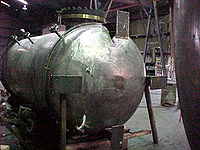Process Vessels
Process Vessels are commonly used in chemical processing. Vessels in chemical processing service are of two kinds: those substantially without internals and those with internals.
The main functions of the first kinds, called drums or tanks, are intermediate storage or surge of a process stream for a limited or extended period or to provide a phase separation by settling. Their sizes may be established by definite process calculations or by general rules based on experience.
The second category comprises the shells of equipment such as heat exchangers, reactors, mixers, fractionators, and other equipment whose housing can be designed and constructed largely independently of whatever internals are necessary. Their major dimensions are established by process requirements described in other chapters, but considerations of adequate strength of vessels at operating pressures and temperatures will be treated in this chapter.
The distinction between drums and tanks is that of size and is not sharp. Usually they are cylindrical vessels with flat or curved ends, depending on the pressure, and either horizontal or vertical. In a continuous plant, drums have a holdup of a few minutes. They are located between major equipment or supply feed or accumulate product.
Surge drums between equipment provide a measure of stability in that fluctuations are not transmitted freely along a chain, including those fluctuations that are characteristic of control instruments of normal sensitivity. For example, reflux drums provide surge between a condenser and its tower and downstream equipment; a drum ahead of a compressor will ensure freedom from liquid entrainment and one ahead of a fired heater will protect the tubes from running dry; a drum following a reciprocating compressor will smooth out pressure surges, etc. Tanks are larger vessels, of several hours holdup usually. For instance, the feed tank to a batch distillation may hold a day's supply, and rundown tanks between equipment may provide several hours holdup as protection of the main storage from possible off-specification product and opportunity for local repair and servicing without disrupting the entire process.
Common Types
Drums
Liquid drums usually are placed horizontal and gas-liquid separators vertical, although reflux drums with gas as an overhead product commonly are horizontal. The length to diameter ratio is in the range 2.5-5.0, the smaller diameters at higher pressures and for liquid-liquid settling.
Fractionator Reflux Drums
Commonly their orientation is horizontal. When a small amount of a second liquid phase (for example, water in an immiscible organic) is present, it is collected in and drawn off a pot at the bottom of the drum.
Liquid-Liquid Separators
Vessels for the separation of two immiscible liquids usually are made horizontal and operate full, although some low rate operations are handled conveniently in vertical vessels with an overflow weir for the lighter phase.
Video
